by DGR Colorado Plateau | Aug 22, 2015 | Colonialism & Conquest, Indigenous Autonomy, Lobbying
Editor’s Note: An original, unabridged version of this article is available at Coal Stop. You can read more and sign up for updates on the proposed Gateway Pacific Terminal at their website.
By Sandy Robson / Intercontinental Cry
United States Senator Steve Daines (R-MT) is on a mission to do whatever it takes to get the Gateway Pacific Terminal (GPT), a 48 million metric-ton-per-year coal export terminal, permitted and built. The GPT project is proposed in Whatcom County, Washington, and would be sited at Xwe’chi’eXen (Cherry Point), along the shoreline, which is part of the Lummi Nation’s traditional fishing area. The company proposing GPT is Pacific International Terminals (PIT), a subsidiary created for the project by SSA Marine.
Tens of thousands of people who steadfastly oppose GPT are standing in the way of Senator Daines, SSA/PIT, and the coal companies like Cloud Peak Energy which have financial interests in seeing that GPT is built and operating. Also standing in the way is the Lummi Indian Tribe, a sovereign nation, standing tall in defense of its treaty rights.
On July 29, Senator Daines’ official website featured a press release about the senator and Congressman Ryan Zinke (R-MT), having led a group of sixteen senators and seventeen members of the House in sending two July 28, 2015 letters (one from the Senate and one from the House) to the U.S. Army Corps of Engineers. The letters urged U.S. Assistant Secretary of the Army Jo-Ellen Darcy, to complete the environmental review process for the proposed GPT project prior to the Corps making a determination whether impacts to any tribes’ U&A (usual and accustomed) treaty fishing rights are more than de minimis, or too trivial to warrant legal review.’
An August 3, 2015 Lummi Nation press release announced that Lummi Indian Business Council (LIBC) Chairman Tim Ballew II sent an August 3 letter to Senator Daines, cc’d to the thirty-two legislators who signed onto those letters, and the Senate Committee on Indian Affairs. In his letter, Ballew reminded them of the U.S. government’s obligation to protect and preserve the Lummi Nation’s treaty fishing rights.
BACKGROUND LEADING UP TO DAINES’ RECENT ACTIONS
In determining whether Lummi Nation’s treaty-guaranteed rights of access to its U&A fishing grounds and stations, and harvest of fish, would be adversely impacted by GPT, the Corps will be applying a de minimis threshold standard. Any impacts considered to be greater than de minimis by the Corps would warrant the GPT permit denial requested by the Lummi Nation.
The fact that the Corps “owes the highest fiduciary duty to protect Indian contract rights as embodied by treaties” is entrenched in case law. That solemn duty and obligation owed to the Lummi Nation by the U.S. federal government is something the agency takes extremely seriously, and addresses separately from any Environmental Impact Statement (EIS) the Corps is tasked with on proposed projects.
Treaty fishing rights of the Lummi are secured to them by the U.S. federal government in the Treaty of Point Elliott of 1855. Article 5 of the Treaty provides that, “The right of taking fish from usual and accustomed grounds and stations is further secured to said Indians in common with all citizens of the Territory. . .”
XWE’CHI’EXEN: WHAT IT MEANS TO THE LUMMI
Lummi Nation’s Sovereignty and Treaty Protection Office Director Jewell James provided some important insight on the significance of Xwe’chi’eXen (Cherry Point) to the Lummi, in the August 2013 issue of Whatcom Watch:
The Lummi have usual and accustomed fishing grounds scattered throughout the San Juan Islands and on the mainland of Whatcom County up to the Canadian border. Not only were our (fishing) village sites located throughout the territory, but the associated burial grounds are located at these sites, as well. Among the most important of these cultural landscapes is Xwe’chi’eXen (Cherry Point).
LIBC Chairman Tim Ballew sent a January 5, 2015 letter to the Army Corps of Engineers, asking the Corps to take action and immediately deny SSA/PIT’s permit application for the proposed GPT project. Ballew wrote:
Review of the impacts associated with this project, including, but not limited to, those analyzed in the Gateway Pacific Terminal Vessell [sic] Traffic and Risk Assessment Study lead to the inescapable conclusion that the proposed project will directly result in a substantial impairment of the treaty rights of the Lummi Nation throughout the Nation’s ‘usual and accustomed’ fishing areas. The Lummi have harvested at this location since time immemorial and plan to continue into the future.
SENATOR ATTEMPTS TO BLOCK ARMY CORPS’ DECISION-MAKING PROCESS
It’s also not surprising that the legislators who signed onto the July 28 letters to the Army Corps, altogether, received over $400,000 in contributions in 2014, from the same GPT-related interests listed above. It’s no surprise that Senator Daines is willing to be Montana coal industry’s point person on the proposed GPT project, because according to opensecrets.org, in 2014, Daines received over $50,000 in total campaign donations from the following contributors connected to the GPT project: Cloud Peak Energy, SSA Marine, FRS Capital Corp. (ultimate parent company of SSA Marine), Peabody Energy, BNSF, Boich Companies (part owner of Global Coal Sales Group, and the National Mining Association (an active advocate for the coal industry).
According to the August 3 Lummi Nation press release previously mentioned in this article, it turns out that the two July 28 letters sent to the Corps by the thirty-two legislators came after three failed attempts by Senator Daines to attach a specifically crafted amendment to various pieces of unrelated legislation. The amendments were designed to try to prohibit the Army Corps from making its determination regarding the Lummi Nation’s treaty fishing rights relating to GPT, before the final EIS would be completed for the project.

Excerpt of Senate Amendment (S.A.) 1809, proposed by Senator Daines on June 8, 2015
One of those amendments, Senate Amendment (S.A.) 1809, was proposed by Senator Daines on June 8. It was an amendment to Senator John McCain’s (R-AZ) Senate Amendment (SA 1463) attached to a piece of unrelated legislation, the National Defense Authorization Act (H.R. 1735) for fiscal year 2016.
Another example of Senator Daines’ attack on Lummi treaty rights was cited in LIBC Chairman Tim Ballew’s August 3 letter to the senator. His letter included a copy of the language that Daines apparently tried to insert as a proposed amendment to yet another piece of unrelated legislation (H.R. 22). The amendment text was the same language that was proposed in S.A. 1809.An excerpt from S.A. 1809 reads, “The Corps of Engineers shall not make any determination regarding usual and accustomed fishing places in connection with the Gateway Pacific Terminal project until after the Corps issues a final environmental impact statement. . .” S.A. 1809 never received debate as it was withdrawn, so it did not move forward to a vote.
Chairman Ballew admonished Senator Daines in the August 3 Lummi Nation press release:
Senator Daines has repeatedly sought to interfere in the Army Corps’ regulatory review process by seeking to attach legislative amendments to various bills moving through Congress. It’s unconscionable that, as a member of the Senate Indian Affairs Committee, he chooses to ignore treaty rights. He has repeatedly tried to diminish the rights of the Lummi Nation using “middle-of-the-night” stealth legislative tactics that have prevented stakeholders from weighing in.
BURYING AMENDMENTS IN UNRELATED LEGISLATION TO BURY TREATY RIGHTS
Amendments are often attached to unrelated bills, but riders that undermine treaties and sacred sites are particularly egregious. In December 2014, Senator McCain successfully buried an amendment he attached to the 1600-page 2015 National Defense Authorization Act (H.R. 4435). The must-pass NDAA legislation that Congress moves yearly was used as a vehicle by McCain to pass a morally suspect public lands exchange package involving land at Oak Flat, in Eastern Arizona.
Senator McCain’s “midnight” rider which disregards and diminishes treaty rights of the San Carlos Apache and other nearby tribes that he managed to sneak through in 2014, and the repeated legislative attempts by Senator Daines to trample Lummi treaty rights, illustrate the serious harm that can befall the Lummi Nation every single day that passes before the Army Corps makes its determination.
SSA Marine’s vice president Skip Sahlin, sent a May 12, 2015 letter to the Army Corps asking for an extension to respond to the Lummi Nation’s request to the Corps for an immediate denial of the GPT permit application because the terminal would interfere and impinge on the Nation’s treaty-protected fishing rights. In that letter, Sahlin claimed that allowing SSA/PIT the requested additional time “will not harm the Tribe or its treaty rights. . .”
The treaty rights of the Lummi Nation are under attack, and their Nation has had to expend untold efforts to defend those rights secured to them in 1855 by the United States. Every day that passes as the Army Corps is making its decision on the fate of the GPT permit, is another opportunity for coal-backed legislators such as Senator Daines to craft legislation aimed at weakening Lummi Nation’s treaty rights. Reasonable persons would conclude that despite Mr. Sahlin’s claim to the contrary, harm has been done to the Lummi Nation each day that has passed since February 2011, when SSA/PIT first submitted the application for its proposed GPT project to Whatcom County’s planning department.
Chairman Ballew made it clear in his letter to Senator Daines that the Lummi Nation will fight resolutely to defend and protect its treaty rights: “I can assure you, that if the Lummi Nation’s Treaty Fishing Rights are jeopardized by any efforts to allow the project to proceed, we will fight vigorously by all means necessary. In times past, our Nation and its leaders did not have the resources and were unable to stop prior efforts to construct commercial terminals in our region. That day is no more.”
From Intercontinental Cry
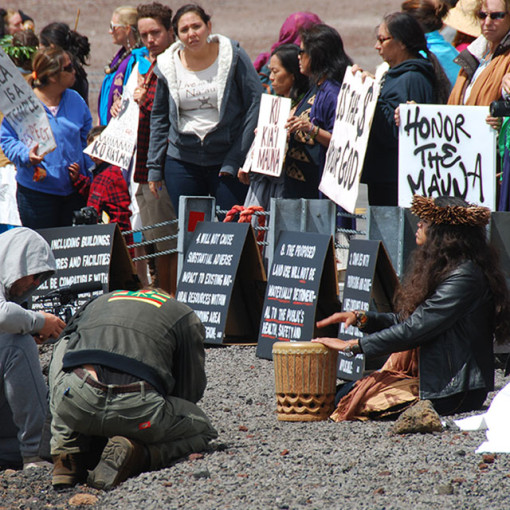
by DGR Colorado Plateau | Aug 21, 2015 | Colonialism & Conquest, Strategy & Analysis, White Supremacy
Editor’s Note: For further analysis of effective resistance movements, please visit the Deep Green Resistance Book, and read about our strategy: Decisive Ecological Warfare.
By Will Falk / Deep Green Resistance
When I am in Hawai’i, I ask everyone I meet if the United States will ever voluntarily de-occupy the Islands. No one ever says yes. Usually, before I can say anything else, people hurriedly start talking about the lack of a valid treaty or that the American occupation is illegal by their own laws or that the United States will pay for its human rights violations.
I am a haole in Hawai’i, a white settler in the United States. I acknowledge that every square inch of the United States of America exists on stolen native land. Leadership in land based struggles in the United States rests most properly in the hands of indigenous peoples. I will not undermine indigenous leadership, so I direct my thoughts to other settlers.
If no one believes that the United Sates will ever voluntarily de-occupy Hawai’i, why are so many of the movement’s settler supporters so focused on achieving this impossible voluntary withdrawal? Why, for example, do so many settlers spend so much energy supporting a parade in Oahu – a parade that is billed as a march for Hawaiian sovereignty while quietly being a voting drive to encourage participation in the occupying American government? Why do so many settlers hold up expensive court cases relying on American judges who are paid by the American government to make decisions leading to this mythical voluntary de-occupation as the only viable means for de-occupation?
The first answer is privilege. Settlers benefit from the current arrangement of power in Hawai’i. These Islands represent the tourist fantasy to many settlers despite the fact that Hawai’i’s life support systems are inches away from total collapse. The inability of settler support to recognize that Hawaiian de-occupation is our responsibility leads me to conclude that most settlers are not as concerned with Hawaiian liberation as they are concerned with maintaining a feel-good environment that balances settler crises of conscience while never threatening settler access to Hawai’i. Hawai’i does not have time to coax these settlers from their positions of privilege. So, I direct my thoughts to settlers of strong heart who simply suffer from a lack of analysis.
Apart from privilege, the second reason settlers have proven unable to mount a serious solidarity effort with the Hawaiian de-occupation movement is they see no alternative to a liberal mindset. “Wait a minute,” I hear a lot of confused readers saying, “Aren’t liberals good?” No, actually. It’s too late to rely exclusively on liberalism. Hawai’i has been cursed for 122 years of occupation with too much liberalism. Liberalism is the haoles’ game. Liberalism serves the United States of America. Liberalism renders resistance ineffective and must be forsaken if de-occupation is to be achieved.
The alternative is radicalism. An examination of the differences between the liberal and radical world views will demonstrate how radicalism arms settlers seeking to demonstrate true solidarity with a better analysis for forming an effective de-occupation strategy. This is not to say that a mixture of tactics cannot be effective. The Hawaiian de-occupation movement should not remove any tool from the table, but the longer Hawai’i remains occupied the clearer it becomes that decisive action is needed.
***
Before I begin, I would like to absolve the term “radical” of the bad reputation it has received in popular circles. Too many people confuse the word “radical” with the word “extreme.” But, as the great African-American activist Angela Davis has explained and as every major dictionary will tell you, the word radical simply means “getting to the root” and is most properly applied to political analyses that seek the origins of oppression.
The brilliant writer and activist Lierre Keith has pointed out two fundamental differences between liberals and radicals. The first difference revolves around individualism. Liberals believe that the basic social unit is the individual, while radicals believe the basic social unit is group or class. This reliance on individualism allows liberals to claim that every individual is entitled to their personal identity free from the realities accompanying social class. In fact, for many liberals, it is an insult to be identified with a certain group regardless of political reality.
For radicals, on the other hand, each individual is socially constructed by political reality. Radicals embrace their social group recognizing it as a source of strength. The first step to affecting change is making common cause with those who share your condition.
The other big difference between liberals and radicals is a disagreement on the nature of social reality. Liberals subscribe to a certain idealism while radicals root their analysis in materialism. For liberals, thoughts, mental states, and attitudes are the only sources and, therefore, solutions for oppression. Liberals locate reality in the human mind and tend to think that education is always the key to social change. For liberals, evil is a misunderstanding and if oppressors can just be shown the error of their ways, they will change.
How does this play out in Hawai’i? Take the role of white supremacism in the domination of Hawai’i, for example. Liberals, long ago, succumbed to the lie that racism and white supremacism are merely emotional states held in the hearts of individuals. They confine the definition of racism to hatred based on the color of one’s skin and confine the definition of white supremacism to hatred for everyone who is not white.
It is astronomers relying on a liberal definition of racism who can claim they are not racist because they hold no hatred in their hearts for the Hawaiian people while still insisting on destroying Mauna Kea’s summit to build telescopes. It is mining executives relying on a liberal definition of white supremacism who can claim no hatred in their hearts for native peoples while insisting that the guts be ripped from native land and poisons pumped into native waters to provide iron ore for the telescopes that destroy native peoples’ sacred sites.
Radicals see tangible systems of power maintained through force and working in the real, physical world as the sources and solutions of oppression. Education is an important first step to building radical consciousness, but they see organized political resistance and force as the means by which real change is achieved. Evil is not a misunderstanding. It is intentional and gives material benefits to oppressors. Oppression is always linked to resource extraction.
An emotional state – like hatred – might contribute to white supremacism, but radicals are less concerned with changing the hearts and minds of those murdering people of color and murdering the world, and more concerned with stopping the destruction. Hawaiian radicals, like Haunani-Kay Trask, for example, see racism as, “A historically created system of power in which one racial/ethnic group dominates another racial/ethnic group for the benefit of the dominating group.” White supremacism is the latest version of this system of power with white people dominating everyone else.
Racism and white supremacism establish, “Economic and cultural domination as well as political power…in the systemic dominance of the exploiting group.” Finally, radicals recognize, as Trask pointed out, that the dominating group holds a monopoly on the means on violence. It is this violence that must be confronted and dismantled if racism and white supremacism are ever truly going to be undermined.
To take this even further, consider what would happen if the liberal analysis was carried out to it’s logical conclusion. Imagine that liberals were actually successful at convincing those in power to treat every one in the world with love and kindness. Without a corresponding change in material reality, there would still be a huge problem. The dominant culture is built on the exploitation of natural resources. Resources are becoming scarcer and scarcer. Humans need to eat, for example, but topsoil is so depleted that major crops are all supported by oil. What will happen, despite the liberal conversion to loving kindness, when the dominant culture needs oil and indigenous peoples and others refuse to give up their lands to give them that oil?
***
A primary strength of the radical analysis is its ability to articulate the role power plays in oppression. Gene Sharp, the world’s foremost authority on civil disobedience and direct action tactics, has identified two manifestations of power – social and political. Social power, for Sharp, is “the totality of all influences and pressures which can be used and applied to groups of people, either to attempt to control the behavior of others directly or indirectly.” Political power is “the total authority, influence, pressure, and coercion which may be applied to achieve or prevent the implementation of the wishes of the power-holder.”
The powerful do everything they can to convince the oppressed that the current arrangement of power is inevitable. To believe power is inevitable is a mistake. Sharp says, “Power, in reality, is fragile, always dependent for its strength and existence upon a replenishment of its sources by the cooperation of a multitude of institutions and people – cooperation which may or may not continue.” The key to Hawaiian de-occupation, then, is dismantling American power. Power is dismantled most effectively by cutting it off at its sources.
Sharp lists six sources of power: authority, human resources, skills and knowledge, intangible factors, material resources, and sanctions. Jacques Maritain defines authority as “the right to command and direct, to be heard or obeyed by others” and Sharp notes that it is enough that those in power be perceived and accepted as superior. Human resources are simply defined as the number of people who obey those in power and will do their bidding. Those in power derive power from the skills, knowledge, and abilities of those who will do their bidding. Closely tied to skills and knowledge, intangible psychological and ideological factors like cultural history and spirituality can be leveraged by those in power to dominate others. Those in power need material resources like property, money, and sources of energy to maintain their power. Finally, those in power must have means to enforce obedience – punishment, in other words, for those who dissent.
The goal of any resistance movement aspiring to true success must engage in shrewd target selection to undermine these sources of power. Taking Sharp a step further, it is possible to prioritize which sources of power are more essential to the functioning of power than others. The most important sources of power are the material resources power depends upon and the brutality of the sanctions they can enact through their commitment to the exploitation of resources. All the other sources of power ultimately depend on the ability of those in power to enforce their power physically. This is a radical conclusion and can be easily demonstrated.
Consider the Overthrow. Did Queen Liliuokalani abdicate the throne because she believed in American authority or the inherent right of Americans to command Hawaiians? Did the Americans command more people to do their bidding in Hawai’i than the Queen? Was Queen Liliuokalani victim to some psychological failing that the Americans exploited?
The answer is obviously no. At the time, Kingdom of Hawai’i supporters outnumbered the Americans over 13 to 1 on the Islands and constituted 4/5 of the legally qualified voters in Hawai’i. Queen Liliuokalani abdicated the throne in order to avoid bloodshed and, according to her June 17, 1897 letter to President William McKinley, because she, “recognized the futility of a conflict with so formidable a power.”
Queen Liliuokalani abdicated the throne because there were 200 United States marines, holding rifles, standing outside her door. Again, it wasn’t the moral superiority of Americans that convinced the Queen. It was, quite clearly, the threat of violence. It is important to understand the physical processes that allowed the Americans to exert that kind of power in Hawai’i. Another way to understand this is to ask, How did a nation existing thousands of miles away on another continent succeed in pointing 200 rifles at Queen Liliuokalani? The answer is, superior material resources.
In order to occupy Hawai’i, Europeans had to get there first. The only way Europeans ever got to Hawai’i and then transported themselves in numbers great enough to gain power was through the use of large naval ships. In order to build these ships, those in power needed wood and lots of it. The U.S.S. Boston that provided the marines and firepower for the Overthrow was in fact one of the American navy’s first steel warships. In order to produce the steel needed to armor the U.S.S. Boston, iron ore must be harvested. To turn iron ore into steel, vast quantities of coal are needed. To mine sufficient quantities of coal, vast tracts of land housing this coal have to be ripped up. To gain access to these vast tracts of land to be ripped up, the indigenous peoples of that land have to be removed or destroyed.
It is true that the other sources of power support the exploitation of the natural world as we can see in the manufacturing of American naval ships. Coal mining, for example, requires human resources. Most humans will not voluntarily mine coal, so those in power have to employ a mixture of authority, psychological coercion, and pure violence to access the coal they need to exert more power. But, the whole system of violence requires material resources. No one is killed by authority alone. Mountain tops are not ripped off by simple knowledge. Belief systems, by themselves, do not colonize indigenous lands. Material action in the physical world produces power. Bullets, swords, or atomic bombs at various stages of human history kill people. Oil-powered excavators and dynamite blow the tops off mountains. Soldiers delivering blankets infected with small pox clear indigenous peoples off their land.
The good news is that the more destructive those in power become, the more complex their system of murder gets, the more opportunities they expose for dismantling their power. Each step in the manufacturing of the U.S.S Boston, for example, presents an opportunity for resisters to stop the replenishment of power at one of its sources. The method is simple. Restrict those in power access to the resources they require and their power weakens. Cut them completely off, and empire comes crashing down.
The physical processes that produce warships and put rifles and cannons in the hands of American troops in Hawai’i follow a similar pattern. These processes are ultimately what make civilization unsustainable. These processes demonstrate precisely how the civilized have come to dominate the world at the expense of the uncivilized and life on this planet. Again, this present state of the world is not inevitable. It is the result of power built through the exploitation of life on the planet. The problem for life right now is the American empire shows no signs of slowing. The bigger their weapons become the faster life is pushed to the brink of total extinction.
Radicalism, then – because it springs from material reality – gives the Hawaiian de-occupation movement an ecological imperative. European contact has resulted in half of Hawai’i’s endemic species being lost to extinction. How many more species must be lost before actions that truly reflect the seriousness of the situation are taken? The American empire is built on the use of fossil fuels and the American military is the single largest consumer of fossil fuels in the world. Burning fossil fuels must be stopped to avoid climate catastrophe. The American military presence is, perhaps, the most serious physical obstacle confronting the de-occupation movement. Blocking the military’s access to imported fossil fuels, then, could deal a decisive blow both to American power on the Islands and American environmental destruction.
***
This is the reality of the challenge confronting the Hawaiian de-occupation movement:The United States will never voluntarily leave Hawai’i and the survival of life on the Islands demands de-occupation. Too many settler liberals would have everyone believe that if Hawaiians just ask nicely enough, or cleverly enough, or with irrefutable American logic, the Americans will leave. Too many settler liberals hold up the American political and international legal systems as the only means for de-occupation. Too many settler liberals can be relied upon for sign-holding events, parades, and social media campaigns to achieve de-occupation, but when it comes down to being accomplices to Hawaiian liberation, we are failing.
Appealing to the American political system hasn’t worked in 122 years. Appealing to the international legal system misunderstands the material reality of power. These liberal tactics can be employed to erode American authority, to persuade humans not to support American power, but there are more decisive routes to undermining American power. It’s not that liberal tactics do not have their place. But, by themselves, they do not undermine power in any serious way.
Time is short in Hawai’i. Settlers wishing to demonstrate true solidarity need to embrace a radical analysis. It is time to get to work seriously dismantling the sources of American power.
Will Falk has been working and living with protesters on Mauna Kea who are attempting to block construction of an 18-story astronomical observatory.
Find an index of Will Falk’s “Protecting Mauna Kea” essays, plus other resources, at:
Deep Green Resistance Hawai’i: Protect Mauna Kea from the Thirty Meter Telescope
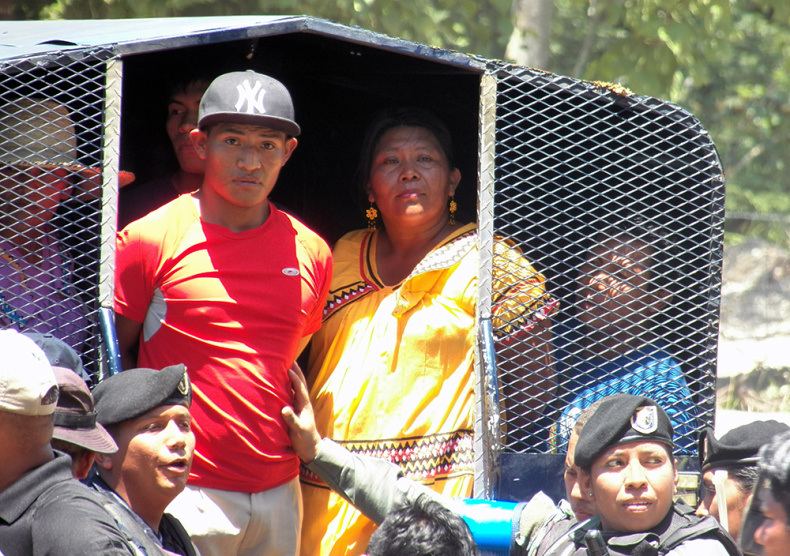
by DGR Colorado Plateau | Aug 6, 2015 | Colonialism & Conquest, Indigenous Autonomy, Obstruction & Occupation
By Richard Arghiris / Intercontinental Cry
Protests against the Barro Blanco hydro dam in western Panama turned violent last Saturday, July 25, when riot police, claiming to act in self-defense, unleashed pepper spray and batons on some 50 Ngäbe activists, women and children among them. At least three protesters were badly injured in the clash.
The crackdown occurred during a visit to the area by the Panamanian Vice President Isabel Saint Malo, who, under the pretext of dialogue, convened three Ngäbe leaders behind closed doors at the Centro Misionero (Mission Centre) in the town of Tolé. Despite a reasonable request to be included in the meeting, leaders from local community groups were excluded. Activists responded to Saint Malo’s move by blockading the Carretera Interamericana, the country’s principle highway.
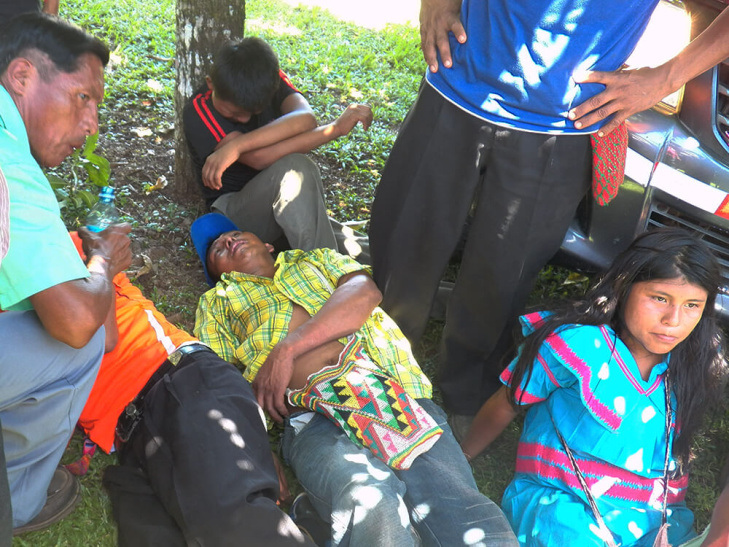
Protesters, including women and children, recover after clashes with the police. (Photo: Oscar Sogandares)
According to the Ngäbe, at around 10:15 am, in scenes reminiscent of the Martinelli years, the police reacted violently to disperse the 50-strong protesters, destroying their equipment, trashing their camps, and burning their banners.
The police deny improper use of force.

Edilma Pinto, 17, suffered a fractured foot during the police crackdown. (Photo: Oscar Sogandares)
Many fled the scene before 20 people were arrested (including several minors) and dispatched to the city of Santiago for processing.
While in the private meeting with Saint Malo, the Cacique of Muná, Chito Gallardo, and the Mayor of Muná, Rolando Carpintero, learned of the arrests and quickly intervened to have them returned. The injured were soon taken to the Casa Misionero for treatment and for the Vice President to bear witness.
According to one person at the scene, the vice president appeared coolly uninterested.

Some 20 Ngäbe protesters were detained by the police. (Photo: Oscar Sogandares)
For several weeks, hundreds of police units have been stationed in and around Tolé, including numerous SENAFRONT troops, an elite militarized squad funded in part by the United States. SENAFRONT is normally charged with defending the jungle frontier with Colombia, making their presence of considerable significance.
Under the US Leahy Law on Human Rights, the US Department of State is prohibited from providing military assistance to foreign units who violate human rights with impunity.

Partly funded by the US State Department, elite SENAFRONT troops have been dispatched to the area. (Photo: Oscar Sogandares)
The clashes on the Interamericana foreshadow greater unrest as Barro Blanco’s owner, Generadora del Istmo (GENISA) – a corporation owned by the controversial Kafie family, now mired in a high-level corruption scandal in Honduras – scrambles to complete the final 5-10% of the hydro dam’s construction.
The company has never sought the free, informed, and prior consent of the indigenous communities living on the banks of the Tabasará river, while the project’s funders, the Dutch and German investment banks FMO and DFE, admit to failing their own due diligence tests. Unfortunately, all funds have now been dispensed to GENISA and the banks themselves made a point of threatening the government when it suspended the project earlier this year.
The negative impacts of Barro Blanco have been identified by scores of technical teams, independent experts, international observers, and the United Nations. Those same impacts are nowhere to be found in GENISA’s Environmental Impact Assessment. Among them, the dam will displace several indigenous and campesino communities, including the community of Kiad, where a unique school and cultural centre is developing the written script of the Ngäbere language.

The ancient Ngabere language is taught at this school house in Kiad. (Photo: Richard Arghiris)
Additional impacts include the loss of farm plots and fish stocks — vital sources of sustenance for indigenous and campesino communities in the region – as well as the loss of several ancient petroglyphs, part of Panama’s national patrimony and a special significance to the Mama Tata religion, a Ngäbe revivalist movement that syncretises indigenous animism and Catholicism.

The Ngabere language is a great source of cultural pride. (Photo: Richard Arghiris)
Among the most devout followers of Mama Tata are the M22 resistance movement, who successfully blockaded the entrance to the dam for 38 consecutive days – until just ten days ago. International news footage of the groups praying and dancing on the highway may have influenced the government’s decision to enforce a ‘soft’ take-over of the site entrance. In contrast to the force deployed outside Tolé, Ngäbe women lying in the path of machinery were carefully removed.
Construction of the dam has now resumed and M22 are continuing to pray day and night by the highway. They complain of psychological intimidation with the police shining high intensity lamps on their camp during the night and aggressively entering the temple they have built near the river banks.
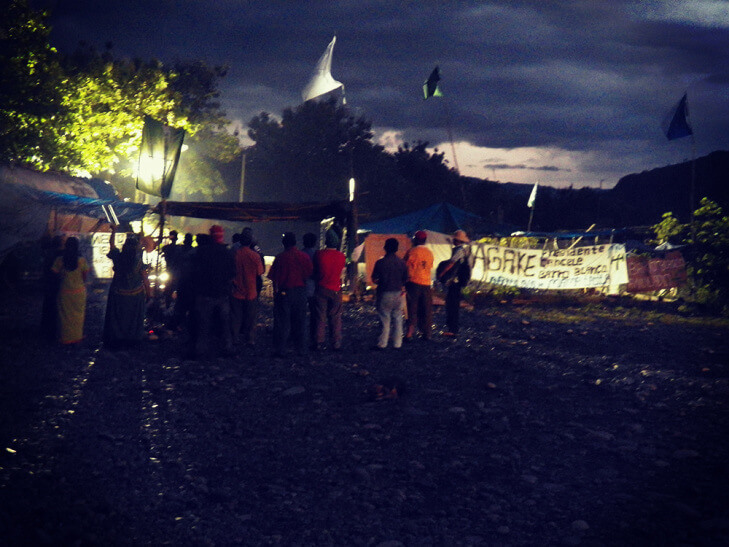
Days before their eviction from the site entrance, M22 gather for prayers under police spotlights. (Photo: Oscar Sogandares)
For his part, Panamanian President Varela, who continues to talk condescendingly about giving the Ngäbe ‘the keys to the dam’ upon its completion, appears to have acquiesced to pressures from his own business community, tacitly enabling foreign corporations who respect neither the environment nor international law nor indigenous or human rights.
The Supreme Court has cheered him on by annulling a moratorium on hydro projects passed by the environment agency, ANAM, who were concerned with the stress being placed on Panama’s delicate but biologically rich watersheds. With the crackdown last week, the Panamanian government appears officially back to business as usual.
From Intercontinental Cry: https://intercontinentalcry.org/barro-blanco-protesters-injured-and-arrested-28467/#imageclose-28472
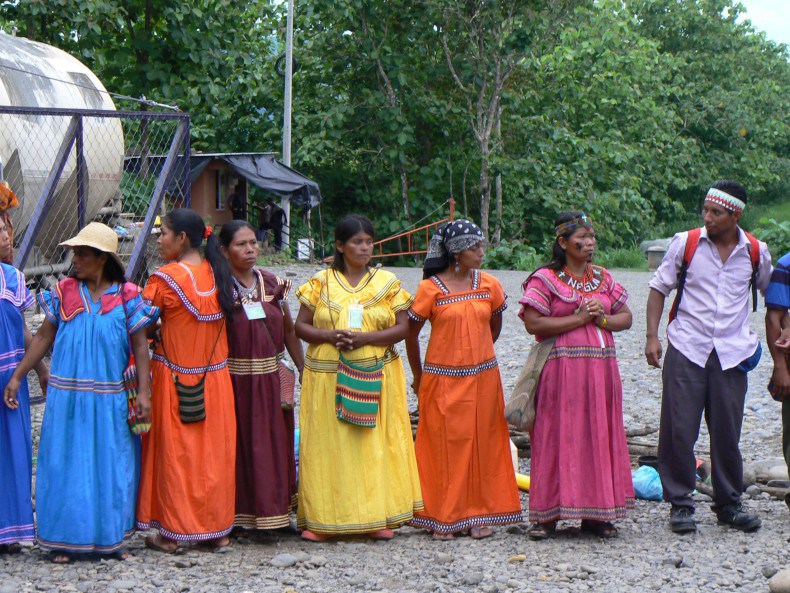
by DGR Colorado Plateau | Aug 5, 2015 | Biodiversity & Habitat Destruction, Colonialism & Conquest, Indigenous Autonomy, Obstruction & Occupation
By Richard Arghiris and Jennifer Kennedy / Intercontinental Cry
June 14, 2015
NGÄBE ISSUE ULTIMATUM TO THE GOVERNMENT OF PANAMA: CANCEL THE PROJECT BY MONDAY
A 30-strong splinter group of Ngäbe from the M10 resistance movement has blocked the entrance to the Barro Blanco hydroelectric dam in western Panama, preventing workers from entering the site. The 15 year struggle of the Tabasará river communities to protect their livelihoods, their culture, and their ancestral heritage now appears to be entering a tense new phase. With negotiations exhausted and the dam 95% complete, M10 has an issued an ultimatum for the government to cancel the project by Monday, June 15, 2015. It is unclear how the government will respond.
“Being Ngäbe-Buglé cultural patrimony,” said Clementina Pérez, part of the group camped at Barro Blanco’s gates. “Our river, our mother earth, our ecology, our existence, we are here to make known to the national and international community that this patrimony belongs to us and to the church of Mama Tata. With the conservation of peace, liberty, justice and unity, liberation and social justice… [we ask] the President of the Republic the cancellation and removal of the dam from our communities, our river and our mother earth, which belong to us as original people of the Americas…”
Funded by European banks – the German Investment Corporation (DEG) and the Dutch Development Bank (FMO) – the dam is set to inundate a string of Ngäbe and campesino communities, all of whom have voiced their objections from the outset. The flood will destroy ancestral petroglyphs, fertile agricultural grounds, and Mama Tata cultural centres, including a unique school where the emerging written script of the Ngäbere language is being developed and disseminated. The dam will significantly impact the river’s marine life, wiping out migratory fish species which many communities – both up and down stream – rely upon for essential protein. None of the Tabasará communities have provided their free, informed and prior consent to the dam, a fact recently confirmed by the FMO’s own independent complaints mechanism (ICM).
“Lenders should have sought greater clarity on whether there was consent to the project from the appropriate indigenous authorities prior to project approval,” said an ICM report, published on May 29, 2015. “[The plan] contains no provision on land acquisition and resettlement and nothing on biodiversity and natural resources management. Neither does it contain any reference to issues related to cultural heritage…”
The report is the latest in a series of professional analyses that pour a thick layer of scorn over the dam project’s owner, Generadora del Istmo (GENISA). Demonstrably unlawful, GENISA has been condemned by numerous independent investigators, the United Nations, several international NGOs, and Panama’s own environmental agency, ANAM, who found a raft of flaws and short-comings in their environmental impact assessment.
But despite failing their own due diligence, the banks appear to have shrugged off the ICM report with an insipid call for “constructive dialogue” and “a solution for a way forward.” In February this year, the FMO chose to threaten the government of Panama after building work was temporarily suspended on the recommendation of ANAM. Writing to the Vice President, the FMO warned that the suspension “May weigh upon future investment decisions, and harm the flow of long-term investments into Panama.”
The government seems to have taken this threat to heart. Panama’s president, Juan Carlos Varela, who was elected to office in 2014, flip-flopped on Barro Blanco before finally falling in line. Last week, while proffering flimsy reassurances about having found a human rights solution, his government left the negotiating table and signaled an end to the suspension of works. M10 claims the work never stopped and has been continuing clandestinely. They are now mobilizing for action.

Clementina Perez (Photo: Oscar Sogandares)
“If this situation is not resolved,” said Clementina Pérez, “We will go to the Panamerican highway to ask together, at a national level, the cancellation of Barro Blanco…”
Rising with stark grey walls above the denuded banks of the Tabasará, Barro Blanco has become a symbol of the previous administration, its fundamental violence and contempt for the rule of law. The former President Ricardo Martinelli – now on the run in the United States and facing a corruption probe back home – provoked no less than four major uprisings as he grasped for land and resources in Panama’s indigenous territories. Heavy-handed repression resulted in the deaths of several protesters and bystanders, including an unarmed teenage boy who was shot in the face by police. Barro Blanco is the visible legacy of a proudly thuggish President who serially abused Panama’s Indigenous Peoples and plundered the country at will. Thus far, Varela has been keen to strike a more decent and humane tone. How he now handles the crisis evolving on the banks of the Tabasará River will be a demonstration of his sincerity, or lack of.
From Intercontinental Cry: https://intercontinentalcry.org/ngabe-block-entry-to-barro-blanco-hydro-dam-panama-28186/

by Deep Green Resistance News Service | Jul 28, 2015 | Climate Change, Lobbying, Strategy & Analysis
By Thomas Linzey / CELDF
Four years ago, as we were leaving Spokane to help rural Pennsylvania communities stop frack injection wells and gas pipelines, this region’s environmental groups couldn’t stop talking about “stopping the coal trains.”
After people in British Columbia – including NASA’s top climate scientist James Hansen – were arrested for blocking oil trains; and after people in Columbia County, Oregon have now proposed a countywide ban on new fossil fuel trains, one would think that both the Spokane City Council and the region’s environmental groups would have begun to take strong steps here to, well, actually stop the coal trains.
After all, there is now almost universal agreement that the continued use of fossil fuels threatens almost every aspect of our lives – from scorching the climate to acidifying the oceans and fomenting widespread droughts.
But it seems that both the Council and this region’s environmental groups have resigned themselves to being silent accomplices to this slow-moving disaster.
A few weeks ago, at a forum on coal and oil trains, rather than propose a citywide ban on oil and coal trains, those groups instead focused on the dangers of train derailments and coal dust – two real issues to be sure – but ones that fall completely short of recognizing the underlying problems posed by the trains.
If the problem is derailments and dust, then the solution is to reinforce and cover the railroad cars. That may or may not happen, but even if it does, it doesn’t solve the fundamental problem posed by the coal and oil trains. Instead, such a stance broadcasts the message from the City of Spokane and this region’s environmental groups that the coal and oil trains are okay as long as they are “safe.”
The real problem, of course, is that the fossil fuels that the oil and coal trains carry – when used the way they are intended to be used – can never be made “safe” because their guaranteed combustion is slowly boiling the very planet on which we live.
At the end of Spokane City Council President Ben Stuckart’s presentation at the forum last week, he spoke about his dead-end meetings with state and federal officials, whose doors were open to the energy and railroad corporations but not to communities affected by the trains. Stuckart declared that he wasn’t sure that anything short of laying down on the tracks would stop the coal and oil trains.
For one brief shining moment, it seemed that the heavens had parted and what we’re really up against – a governmental system controlled by the very corporations it is ostensibly supposed to regulate – came shining through.
As I watched, people across the room began to shout and applaud; and then, just as quickly as it had come, it passed, as the hosts of the forum steered everyone back to their latest moving target – this time, urging people to write letters begging Governor Inslee to stop proposed oil and gas exports. In other words, now nicely asking the Governor to stop more oil and coal trains from invading Spokane.
I then realized why I stopped going to those gatherings – I stopped because the form of activism proposed by the groups actually strips us of the belief that we’re capable of doing anything by ourselves, as a community, to actually stop the trains. Writing letters reinforces a hopelessness of sorts – that we’re completely dependent on the decision by others to “save” us, and that we’re incapable of taking action to save ourselves.
It would be akin to the civil rights movement writing letters to congress instead of occupying the lunch counter or the seats at the front of the bus. Or Sam Adams sending a letter to King George urging him to put safety bumpers on the ships carrying tea, rather than having a tea party by dumping casks of tea in the harbor.
Until we confront the energy and railroad corporations directly, they will continue to treat Spokane as a cheap hotel. We need to ban and stop the trains now – using everything that we can – before future generations wonder why we spent so much time sending letters and so little time protecting them.
Thomas Alan Linzey, Esq., is the Executive Director of the Community Environmental Legal Defense Fund and a resident of the City of Spokane. The Legal Defense Fund has assisted over two hundred communities across the country, including the City of Pittsburgh, to adopt local laws stopping corporate factory farms, waste dumping, corporate water withdrawals, fracking, and gas pipelines. He is a cum laude graduate of Widener Law School and a three-time recipient of the law school’s public interest law award. He has been a finalist for the Ford Foundation’s Leadership for a Changing World Award, and is a recipient of the Pennsylvania Farmers Union’s Golden Triangle Legislative Award. He is admitted to practice in the United States Supreme Court, the Third, Fourth, Eighth, and Tenth Circuit Courts of Appeals, the U.S. District Court for the Western and Middle Districts of Pennsylvania, and the Commonwealth of Pennsylvania. Linzey was featured in Leonardo DiCaprio’s film 11th Hour, assisted the Ecuadorian constitutional assembly in 2008 to adopt the world’s first constitution recognizing the independently enforceable rights of ecosystems, and is a frequent lecturer at conferences across the country. His work has been featured in the New York Times, the Los Angeles Times, Mother Jones, the Nation magazine, and he was named, in 2007, as one of Forbes’ magazines’ “Top Ten Revolutionaries.” He can be reached at tal@pa.net.
by DGR Colorado Plateau | Jun 22, 2015 | Building Alternatives, Gender, Strategy & Analysis
In 1993 Michael Carter was arrested and indicted for underground environmental activism. Since then he’s worked aboveground, fighting timber sales and oil and gas leasing, protecting endangered species, and more. Today, he’s a member of Deep Green Resistance Colorado Plateau, and author of the memoir Kingfishers’ Song: Memories Against Civilization.
Time is Short spoke with him about his actions, underground resistance, and the prospects and problems facing the environmental movement. The first part of this interview is available here, and the second part here.
Time is Short: You mentioned some problems of radical groups—lack of respect for women and lack of a strategy. Could you expand on that?
Michael Carter: Sure. To begin with, I think both of those issues arise from a lifetime of privilege in the dominant culture. Men in particular seem prone to nihilism; I certainly was. Since we were taught—however unwittingly—that men are entitled to more of everything than women, our tendency is to bring this to all our endeavors.
I will give some credit to the movie “Night Moves” for illustrating that. The men cajole the woman into taking outlandish risks and they get off on the destruction, and that’s all they really do. When an innocent bystander is killed by their action, the woman has an emotional breakdown. She’s angry with the men because they told her no one would get hurt, and she breaches security by talking to other people about it. Their cell unravels and they don’t even explore their next options together. Instead of providing or even offering support, one of the men stalks and ultimately kills the woman to protect himself from getting caught, then vanishes back into mainstream consumer culture. So he’s not only a murderer but ultimately a cowardly hypocrite, as well.
Honestly, it appears to be more of an anti-underground propaganda piece than anything. Or maybe it’s just a vapid film, but it does have one somewhat valid point—that we white Americans, particularly men, are an overprivileged self-centered lot who won’t hesitate to hurt anyone who threatens us.

Artwork by Stephanie McMillan
That’s a fictional example, but any female activist can tell you the same thing. And of course misogyny isn’t limited to underground or militant groups; I saw all sorts of male self-indulgence and superiority in aboveground circles, moderate and radical both. It took hindsight for me to recognize it, even in myself. That’s a central problem of radical environmentalism, one reason why it’s been so ineffective. Why should any woman invest her time and energy in an immature movement that holds her in such low regard? I’ve heard this complaint about Occupy groups, anarchists, aboveground direct action groups, you name it.
Groups can overcome that by putting women in positions of leadership and creating secure, uncompromised spaces for them to do their work. I like to reflect on the multi-cultural resistance to the Burmese military dictatorship, which is also a good example of a combined above- and underground effort, of militant and non-violent tactics. The indigenous people of Burma traditionally held women in positions of respect within their cultures, so they had an advantage in building that into their resistance movements, but there’s no reason we couldn’t imitate that anywhere. Moreover, if there are going to be sustainable and just cultures in the future, women are going to be playing critical roles in forming and running them, so men should be doing everything possible to advocate for their absolute human rights.
As for strategy, it’s a waste of risk-taking for someone to cut down billboards or burn the paint off bulldozers. It’s important not to equate willingness with strategy, or radicalism and militancy with intelligence. For example, I just noticed an oil exploration subcontractor has opened an office in my town. Bad news, right? I had a fleeting wish to smash their windows, maybe burn the place down. That’ll teach ‘em, they’ll take us seriously then. But it wouldn’t do anything, only net the company an insurance settlement they’d rebuild with and reinforce the image of militant activists as mindless, dangerous thugs.
If I were underground, I’d at least take the time to choose a much more costly and hard-to-replace target. I’d do everything I could to coordinate an attack that would make it harder for the company to recover and continue doing business. And I’d only do these things after I had a better understanding of the industry and its overall effects, and a wider-focused examination of how that industry falls into the mechanism of civilization itself.
By widening the scope further, you see that ending oil and gas development might better be approached from an aboveground stance—by community rights initiatives, for example, that have outlawed fracking from New York to Texas to California. That seems to stand a much better chance of being effective, and can be part of a still wider strategy to end fossil fuel extraction altogether, which would also require militant tactics. You have to make room for everything, any tactic that has a chance of working, and begin your evaluation there.
To use the Oak Flat copper mine example, now the mine is that much closer to happening, and the people working against it have to reappraise what they have available. That particular issue involves indigenous sacred sites, so how might that be respectfully addressed, and employed in fighting the mine aboveground? Might there be enough people to stop it with civil disobedience? Is there any legal recourse? If there isn’t, how might an underground cell appraise it? Are there any transportation bottlenecks to target, any uniquely expensive equipment? How does timing fit in? How about market conditions—hit them when copper prices are down, maybe? Target the parent company or its other subsidiaries? What are the company’s financial resources?
An underground needs a strategy for long-term success and a decision-making mechanism that evaluates other actions. Then they can make more tightly focused decisions about tactics, abilities, resources, timing, and coordinated effort. The French Resistance to the Nazis couldn’t invade Berlin, but they sure could dynamite train tracks. You wouldn’t want to sabotage the first bulldozer you came across in the woods; you’d want to know who it belonged to, if it mattered, and that you weren’t going to get caught. Maybe it belongs to a habitat restoration group, who can say? It doesn’t do any good to put a small logging contractor out of business, and it doesn’t hurt a big corporation to destroy machinery that is inexpensive, so those questions need to be answered beforehand. I think successful underground strikes must be mostly about planning; they should never, never be about impulse.
TS: There are a lot of folks out there who support the use of underground action and sabotage in defense of Earth, but for any number of reasons—family commitments, physical limitations, and so on—can’t undertake that kind of action themselves. What do you think they can do to support those willing and able to engage in militant action?
MC: Aboveground people need to advocate underground action, so those who are able to be underground have some sort of political platform. Not to promote the IRA or its tactics (like bombing nightclubs), but its political wing of Sinn Fein is a good example. I’ve heard a lot of objections to the idea of advocating but not participating in underground actions, that there’s some kind of “do as I say, not as I do” hypocrisy in it, but that reflects a misunderstanding of resistance movements, or the requirements of militancy in general. Any on-the-ground combatant needs backup; it’s just the way it is. And remember that being aboveground doesn’t guarantee you any safety. In fact, if the movement becomes effective, it’s the aboveground people most vulnerable to harm, because they’re going to be well known. In that sense, it’s safer to be underground. Think of the all the outspoken people branded as intellectuals and rounded up by the Nazis.
The next most important support is financial and material, so they can have some security if they’re arrested. When environmentalists were fighting logging in Clayoquot Sound on Vancouver Island in the 1990s, Paul Watson (of the Sea Shepherd Conservation Society) offered to pay the legal defense of anyone caught tree spiking. Legal defense funds and on-call pro-bono lawyers come immediately to mind, but I’m sure that could be expanded upon. Knowing that someone is going to help if something horrible happens, combatants can take more initiative, can be more able to engineer effective actions.
We hope there won’t be any prisoners, but if there are, they must be supported too. They can’t just be forgotten after a month. As I mentioned before, even getting letters in jail is a huge morale booster. If prisoners have families, it’s going to make a big difference for them to know that their loved ones aren’t alone and that they will have some sort of aboveground material support. This is part of what we mean when we talk about a culture of resistance.
TS: You’ve participated in a wide range of actions, spanning the spectrum from traditional legal appeals to sabotage. With this unique perspective, what do you see as being the most promising strategy for the environmental movement?
MC: We need more of everything, more of whatever we can assemble. There’s no denying that a lot of perfectly legal mainstream tactics can work well. We can’t litigate our way to sustainability any more than we can sabotage our way to sustainability; but for the people who are able to sue the enemy, that’s what they should be doing. Those who don’t have access to the courts (which is most everyone) need to find other roles. An effective movement will be a well-organized movement, willing to confront power, knowing that everything is at stake.
Decisive Ecological Warfare is the only global strategy that I know of. It lays out clear goals and ways of arranging above- and underground groups based on historical examples of effective movements. If would-be activists are feeling unsure, this might be a way for them to get started, but I’m sure other plans can emerge with time and experience. DEW is just a starting point.
Remember the hardest times are in the beginning, when you’re making inevitable mistakes and going through abrupt learning curves. When I first joined Deep Green Resistance, I was very uneasy about it because I still felt burned out from the ‘90s struggles. What I’ve discovered is that real strength and endurance is founded in humility and respect. I’ve learned a lot from others in the group, some of whom are half my age and younger, and that’s a humbling experience. I never really understood what a struggle it is for women, either, in radical movements or the culture at large; my time in DGR has brought that into focus.
Look at the trans controversy; here are males asking to subordinate women’s experiences and safe spaces so they can feel comfortable. It’s hard for civilized men to imagine relationships that aren’t based on the dominant-submissive model of civilization, and I think that’s what the issue is really about—not phobia, not exclusionary politics, but rather role-playing that’s all about identity. Male strength traditionally comes from arrogance and false pride, which naturally leads to insecurity, fear, and a need to constantly assert an upper hand, a need to be right. A much more secure stance is to recognize the power of the earth, and allow ourselves to serve that power, not to pretend to understand or control it.
 TS: We agree that time is not on our side. What do you think is on our side?
TS: We agree that time is not on our side. What do you think is on our side?
MC: Three things: first, the planet wants to live. It wants biological diversity, abundance, and above all topsoil, and that’s what will provide any basis for life in the future. I think humans want to live, too; and more than just live, but be satisfied in living well. Civilization offers only a sorry substitute for living well to only a small minority.
The second is that activists now have a distinct advantage in that it’s easier to get information anonymously. The more that can be safely done with computers, including attacking computer systems, the better—but even if it’s just finding out whose machinery is where, how industrial systems are built and laid out, that’s much easier to come by. On the other hand the enemy has a similar advantage in surveillance and investigation, so security is more crucial than ever.
The third is that the easily accessible resources that empires need to function are all but gone. There will never be another age of cheap oil, iron ore mountains, abundant forest, and continents of topsoil. Once the infrastructure of civilized humanity collapses or is intentionally broken, it can’t really be rebuilt. Then humans will need to learn how to live in much smaller-scale cultures based on what the land can support and how justly they treat one another. That will be no utopia, of course, but it’s still humanity’s best option. The fight we’re now engaged in is over what living material will be available for those new, localized cultures—and more importantly, the larger nonhuman biological communities—to sustain themselves. What polar bears, salmon, and migratory birds need, we will also need. Our futures are forever linked.
Time is Short: Reports, Reflections & Analysis on Underground Resistance is a bulletin dedicated to promoting and normalizing underground resistance, as well as dissecting and studying its forms and implementation, including essays and articles about underground resistance, surveys of current and historical resistance movements, militant theory and praxis, strategic analysis, and more. We welcome you to contact us with comments, questions, or other ideas at undergroundpromotion@deepgreenresistance.org


















